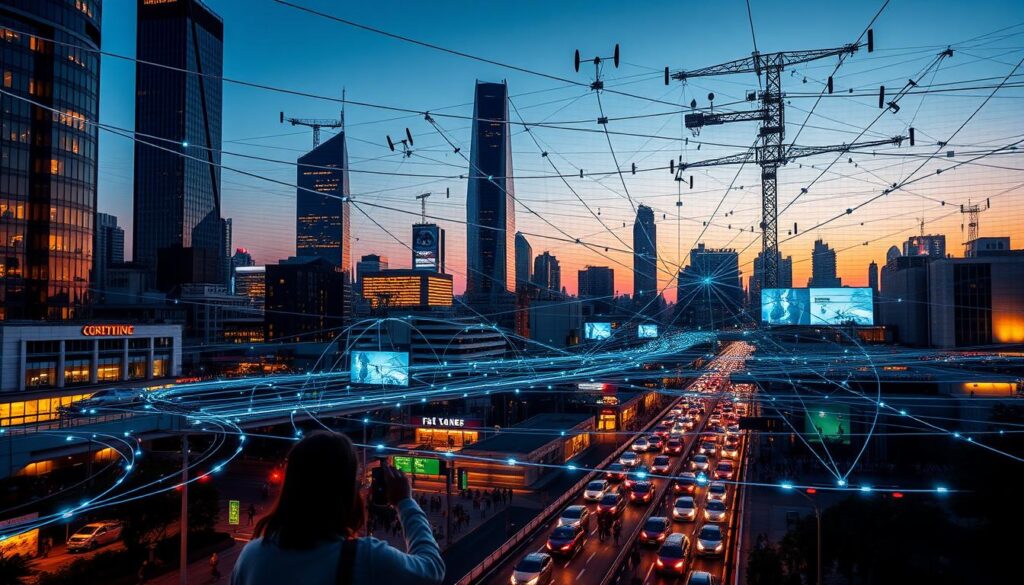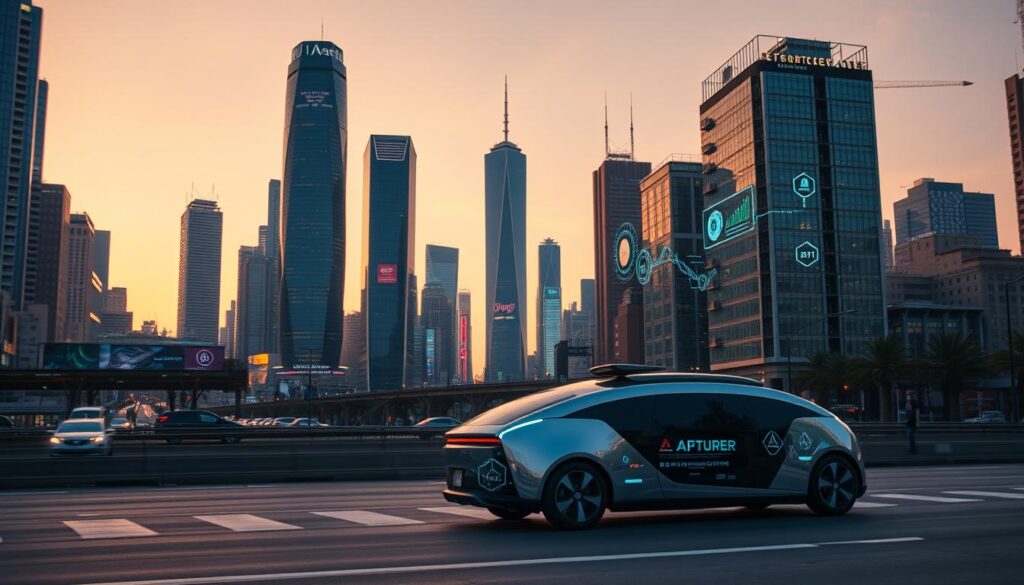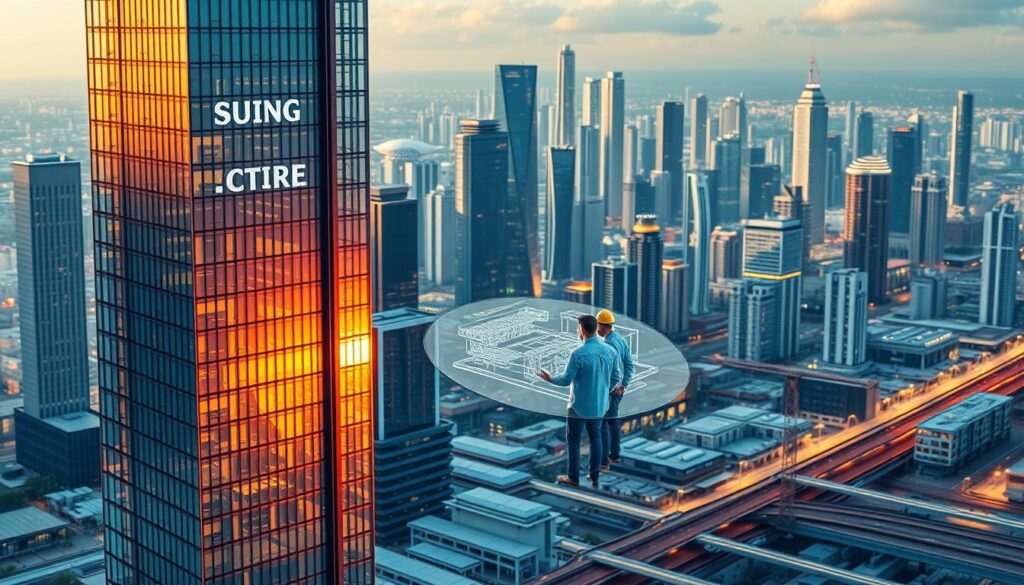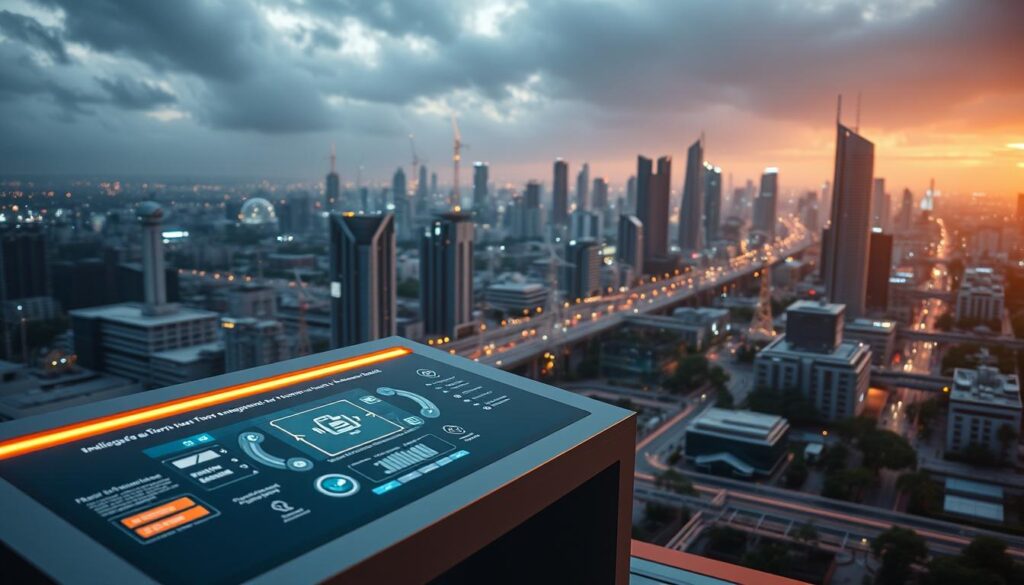As we head , cities around the world are continuing to adapt and evolve to meet the needs of their citizens. Over 60% of the global population is expected to live in urban areas by 2030, putting a strain on city resources and infrastructure.
The years is expected to bring significant advancements in smart city technologies, transforming the way cities operate and interact with their citizens. From transportation and mobility to energy and real estate, several key trends are shaping the future of our communities.
Key Takeaways
- Advancements in smart city technologies will transform urban development.
- Increased focus on sustainability and energy efficiency.
- Integration of transportation and mobility systems.
- Improved citizen engagement through technology.
- Enhanced data analytics for informed decision-making.
Introduction to Smart City Building Technology
As cities evolve, the integration of smart building technology is becoming increasingly crucial. This integration is not just about adopting new technologies; it’s about creating a more sustainable, efficient, and livable urban environment.
What Defines a Smart City?
A smart city is defined by its ability to integrate technology into its infrastructure to improve the quality of life for its citizens. This involves using advanced technologies to create a more efficient, sustainable, and livable environment. For instance, smart cities utilize sustainable building materials and innovative energy solutions to minimize their ecological footprint.
The Importance of Sustainable Design
Sustainable design plays a critical role in smart city development. It enables cities to reduce their environmental impact while promoting economic growth. By incorporating green spaces, energy-efficient buildings, and sustainable transportation systems, cities can create a healthier environment for their citizens. Moreover, sustainable design can enhance the aesthetic appeal of urban areas, making them more attractive to residents and visitors alike.
The importance of sustainable design cannot be overstated. It is essential for creating a better future for our communities. By adopting sustainable practices and leveraging building technology trends, cities can ensure a more sustainable and prosperous future.
Internet of Things (IoT) in Urban Infrastructure

With IoT, cities can now leverage real-time data to make informed decisions about their infrastructure. The Internet of Things is transforming urban infrastructure by enabling cities to collect and analyze data in real-time, thereby improving their overall efficiency and management.
Smart Sensors and Their Applications
Smart sensors are being used to monitor and manage various aspects of city operations, from traffic flow to energy consumption. These sensors provide real-time data that can be used to optimize city services, reduce waste, and enhance the quality of life for citizens. For instance, smart traffic sensors can help manage traffic congestion by adjusting signal timings based on real-time traffic conditions.
The applications of smart sensors are vast and varied. They can be used in transportation systems to monitor traffic and optimize routes, in energy management to monitor and control energy usage, and in public safety to detect and respond to emergencies.
Enhancing Efficiency with IoT
IoT technologies are enhancing the efficiency of urban infrastructure by providing real-time insights into city operations. By leveraging IoT, cities can optimize their services, reduce operational costs, and improve the overall quality of life for their citizens. According to a report by Peerbits, IoT is driving urban development and smart cities by enabling data-driven decision-making.
For example, IoT-enabled smart lighting systems can adjust lighting levels based on the time of day and occupancy, reducing energy consumption and lowering costs. Similarly, IoT-based waste management systems can optimize waste collection routes and schedules, reducing waste and improving public health.
Real-Time Data for Better Decision Making
The real-time data collected by IoT devices enables cities to make better-informed decisions about their infrastructure and services. By analyzing this data, cities can identify areas of inefficiency, optimize resource allocation, and improve their overall performance. Real-time data can also be used to respond to emergencies and mitigate the impact of natural disasters.
For instance, real-time data from IoT sensors can be used to monitor weather conditions, detect natural disasters, and trigger emergency responses. This can help cities to reduce the impact of disasters and save lives.
Advances in Green Building Materials
Advances in green building materials are playing a crucial role in reducing the environmental footprint of urban development. As cities continue to grow, the need for sustainable construction practices becomes increasingly important. The use of green building materials is becoming a cornerstone in the quest for more environmentally friendly urban infrastructure.
Benefits of Sustainable Materials
Sustainable materials offer numerous benefits, including reduced energy consumption, lower greenhouse gas emissions, and improved indoor air quality. According to a study, buildings constructed with sustainable materials can reduce energy consumption by up to 30%. The use of sustainable materials is not just an environmental imperative but also an economic one, as it can lead to significant cost savings over the lifecycle of a building.
“The future of construction lies in sustainability,” says an industry expert. “Green building materials are not just a trend; they are the future of how we build.” This shift towards sustainability is driven by both regulatory requirements and consumer demand for greener buildings.
Innovations in Energy Efficiency
Innovations in energy efficiency are being driven by the development of new materials and technologies. For instance, the use of phase-change materials in building construction can help regulate indoor temperatures, reducing the need for heating and cooling. Additionally, advancements in cutting-edge technology are enabling the creation of more energy-efficient buildings.
- Improved insulation materials
- Energy-efficient windows
- Smart building technologies
Smart Glass and Environmental Control
Smart glass technology is another significant advancement in green building materials. This technology allows for the control of light and heat entering a building, thereby reducing energy consumption. Smart glass can be integrated into windows and facades, providing both energy efficiency and aesthetic appeal.
The integration of smart glass and other green building materials is a step towards creating buildings that are not only sustainable but also responsive to their occupants’ needs. As the construction industry continues to evolve, the adoption of such technologies is expected to become more widespread.
The Role of Artificial Intelligence

As cities become smarter, the role of AI in optimizing urban operations and services is becoming increasingly significant. Artificial intelligence is being leveraged to improve various aspects of city management, from urban planning to public safety.
AI in Urban Planning
AI is transforming urban planning by enabling cities to analyze vast amounts of data and make informed decisions. With AI, cities can predict population growth, traffic patterns, and energy demands, allowing for more efficient planning and resource allocation.
Key Applications of AI in Urban Planning:
- Predictive analytics for infrastructure development
- Optimizing traffic flow and reducing congestion
- Enhancing public transportation systems
Predictive Maintenance for Infrastructure
AI-powered predictive maintenance is revolutionizing the way cities manage their infrastructure. By analyzing data from sensors and IoT devices, AI can predict when maintenance is required, reducing downtime and improving overall infrastructure efficiency.
| Benefits | Description |
|---|---|
| Reduced Maintenance Costs | Predictive maintenance helps in identifying potential issues before they become major problems, thus reducing maintenance costs. |
| Increased Infrastructure Lifespan | Regular and timely maintenance extends the lifespan of infrastructure, delaying the need for costly replacements. |
| Enhanced Public Safety | By preventing infrastructure failures, predictive maintenance contributes to a safer environment for citizens. |
Enhancing Public Safety with AI
AI is also being used to enhance public safety in smart cities. Through the analysis of data from various sources, including surveillance cameras and sensors, AI can help predict and prevent crime, improving response times and overall safety.
Examples of AI in Public Safety:
- Predictive policing to prevent crimes
- Real-time surveillance analysis for immediate response
- Emergency response systems that quickly alert authorities to incidents
The integration of AI in smart cities is a significant step towards creating more sustainable, efficient, and safe urban environments. As technology continues to evolve, the potential applications of AI in city management are expected to grow, leading to even more innovative solutions.
Integrating Renewable Energy Solutions
As cities continue to evolve, the integration of renewable energy solutions is becoming a pivotal aspect of smart city development. The shift towards sustainability is driven by the need to reduce environmental impact and enhance energy efficiency. Renewable energy sources are being increasingly adopted in urban areas to power homes, businesses, and transportation systems.
Solar Panels in Urban Spaces
Solar panels are being integrated into urban infrastructure, from rooftops to streetlights. This not only reduces the carbon footprint but also provides a sustainable source of energy. For instance, cities are now incorporating solar panel technology into building design, enhancing energy efficiency and reducing reliance on non-renewable energy sources.
According to recent trends, the adoption of solar energy is expected to continue growing in 2023, with significant applications in areas such as transportation and energy management. As highlighted in a recent report, “The future of energy lies in harnessing the power of the sun and other renewable sources to create sustainable and resilient cities.”
“The transition to renewable energy is not just an environmental imperative, but also an economic opportunity.”
Wind Energy Adoption in Cities
Wind energy is another critical component of renewable energy solutions. Cities are now adopting wind energy technologies, including wind turbines, to generate power. This adoption is part of a broader strategy to diversify energy sources and reduce dependence on fossil fuels.
For more information on the latest trends in green infrastructure, visit World Civil Society.
Other Innovative Energy Sources
Beyond solar and wind, other innovative energy sources are being explored. For example, hydrogen fuel cells are gaining attention for their potential to provide clean energy. These emerging technologies are crucial for creating a diverse and resilient energy mix in smart cities.
The integration of these renewable energy solutions is expected to play a significant role in shaping the future of urban development, making cities more sustainable and environmentally friendly.
Building Information Modeling (BIM)

Building Information Modeling (BIM) is at the forefront of innovation in construction planning and execution. It is revolutionizing the construction industry by enabling real-time collaboration and data analysis, thereby improving the planning, design, and construction of buildings.
The Future of Construction Planning
The use of BIM is expected to continue growing in 2023, with significant applications in areas such as construction planning, collaboration, and project monitoring. By utilizing BIM, architects, engineers, and contractors can collaborate more effectively, reducing errors and improving overall efficiency.
For more insights on the future of BIM and its impact on smart cities, visit The Future of BIM and Smart.
Effective Collaboration through BIM
BIM facilitates effective collaboration among various stakeholders by providing a shared platform for data exchange and project visualization. This leads to better decision-making and reduced misunderstandings during the construction process.
Real-Time Project Monitoring
One of the key benefits of BIM is its ability to enable real-time project monitoring. This allows project managers to track progress, identify potential issues, and make timely interventions, ensuring that projects stay on schedule and within budget.
In conclusion, BIM is transforming the construction industry by providing innovative building solutions and driving urban technology trends. Its impact on construction planning, collaboration, and project monitoring is significant, and its adoption is expected to continue growing in the coming years.
Smart Transit Solutions
The integration of technology in transportation is giving rise to smart transit solutions that are more efficient, sustainable, and reliable. These solutions are transforming the way cities approach transportation, making it a vital component of smart city building tech trends in 2023.
Autonomous Vehicles in Urban Areas
Autonomous vehicles are at the forefront of smart transit solutions, offering a promising future for urban transportation. With the ability to navigate through complex urban environments, these vehicles are expected to reduce traffic congestion and enhance safety. Companies like Smart Transit AI are already working on implementing autonomous vehicle technology in various cities.
Enhancing Public Transport with Technology
Technology is being increasingly used to enhance public transport systems, making them more efficient and user-friendly. This includes the use of real-time data analytics to optimize bus and train schedules, as well as the implementation of smart payment systems. By leveraging these technologies, cities can improve the overall public transportation experience, encouraging more people to use these services.
Smart Traffic Management Systems
Smart traffic management systems are another crucial aspect of smart transit solutions. These systems use advanced technologies like IoT sensors and data analytics to monitor and manage traffic flow in real-time. By optimizing traffic signal timings and providing real-time traffic updates, cities can reduce congestion and minimize travel times, making urban transportation more efficient.
In conclusion, smart transit solutions are revolutionizing urban transportation by integrating cutting-edge technology and sustainable building practices. As cities continue to adopt these solutions, we can expect to see significant improvements in the efficiency, sustainability, and reliability of transportation systems.
Energy Management Systems

The integration of energy management systems is revolutionizing the way cities approach energy consumption and sustainability. As part of the broader smart city initiatives, these systems are designed to optimize energy use, reduce waste, and promote a more sustainable urban environment.
Reducing Energy Consumption in Buildings
One of the primary focuses of energy management systems is reducing energy consumption in buildings. This is achieved through the use of advanced technologies such as smart meters, energy-efficient lighting, and HVAC systems. By monitoring and controlling energy usage in real-time, buildings can significantly lower their energy consumption, leading to cost savings and a reduced carbon footprint.
Smart technologies enable building managers to identify areas of inefficiency and implement corrective measures. For instance, smart thermostats can learn occupancy patterns and adjust heating and cooling accordingly, minimizing unnecessary energy use.
Smart Grids and Their Impact
Smart grids are another critical component of energy management systems. They enable the efficient distribution of electricity by using advanced technologies like IoT sensors and real-time data analytics. This not only improves the reliability of the grid but also allows for the integration of renewable energy sources, further reducing the reliance on fossil fuels.
The impact of smart grids on energy management is significant. They enable demand response strategies that adjust energy consumption based on supply conditions, thereby preventing grid overload and reducing the likelihood of power outages.
The Role of Energy Storage Solutions
Energy storage solutions play a vital role in energy management systems by providing a buffer against fluctuations in energy supply and demand. Technologies like batteries and other innovative storage solutions enable cities to store excess energy generated from renewable sources, which can then be used during periods of high demand.
The integration of energy storage solutions with smart grids and energy management systems is a key new technology trend in smart cities worldwide. It enhances the overall efficiency and sustainability of urban energy systems, paving the way for a more resilient and environmentally friendly urban infrastructure.
Smart Waste Management
Efficient waste management is a cornerstone of smart city initiatives, utilizing advanced technologies to minimize landfill waste and enhance recycling rates. As urban populations grow, the need for innovative waste management solutions becomes increasingly critical.
Efficient Waste Tracking with IoT
The integration of IoT technologies in waste management is transforming the way cities handle waste. Smart waste bins equipped with sensors can monitor waste levels, composition, and other relevant data, enabling cities to optimize waste collection routes and schedules. This not only reduces operational costs but also decreases the environmental impact of waste collection vehicles.
Moreover, IoT-enabled waste tracking systems can help identify areas with high waste generation rates, allowing for targeted waste reduction initiatives. By leveraging real-time data, cities can make informed decisions to improve waste management efficiency.
Recycling Technologies in Smart Cities
Recycling is a critical component of smart waste management. Advanced recycling technologies, such as artificial intelligence-powered sorting machines, are enhancing the efficiency and effectiveness of recycling processes. These technologies can identify and sort recyclable materials more accurately than traditional methods, increasing the overall recycling rate.
Furthermore, smart cities are adopting innovative recycling programs that encourage citizen participation. For instance, some cities are implementing pay-as-you-throw schemes, where residents are charged based on the amount of waste they generate, incentivizing them to reduce and recycle more.
Reducing Landfill Waste
One of the primary goals of smart waste management is to minimize landfill waste. By implementing efficient waste tracking, enhancing recycling technologies, and promoting waste reduction practices, cities can significantly decrease the amount of waste sent to landfills.
Additionally, some smart cities are exploring alternative waste-to-energy technologies that can convert non-recyclable waste into energy, further reducing landfill waste. These initiatives not only contribute to a cleaner environment but also help in achieving sustainability goals.
In conclusion, smart waste management is a vital aspect of smart city development, leveraging technologies like IoT and advanced recycling to create more sustainable urban environments. As cities continue to evolve, the adoption of smart waste management practices will play a crucial role in achieving environmental sustainability and enhancing the quality of life for urban residents.
Enhancing Urban Mobility

The quest for better urban mobility is driving innovation in cities worldwide. As urban populations grow, the need for efficient, sustainable transportation solutions becomes increasingly important.
Electric Vehicle Charging Stations
One significant development in urban mobility is the expansion of electric vehicle (EV) charging infrastructure. Cities are investing heavily in EV charging stations to support the growing number of electric vehicles on the road. For instance, a study by the International Energy Agency found that the number of public EV charging points worldwide reached over 1 million in 2022.
To further understand the growth and distribution of EV charging stations, let’s examine the data in the following table:
| Year | Number of Public EV Charging Points | Growth Rate (%) |
|---|---|---|
| 2020 | 500,000 | 20 |
| 2021 | 700,000 | 40 |
| 2022 | 1,000,000 | 43 |
Walkability and Bicycle Infrastructure
Enhancing walkability and bicycle infrastructure is another crucial aspect of urban mobility. Cities are designing more pedestrian-friendly and cyclist-friendly environments by creating dedicated bike lanes and improving sidewalk accessibility. According to a report by the Parking & Mobility Magazine, investments in cycling infrastructure can lead to significant increases in cycling rates and reductions in traffic congestion.
Key benefits of improved walkability and bicycle infrastructure include:
- Reduced traffic congestion
- Improved air quality
- Enhanced public health through increased physical activity
- Economic benefits from increased local business patronage
Smart Parking Solutions
Smart parking solutions are also playing a vital role in enhancing urban mobility. By leveraging technologies such as IoT sensors and data analytics, cities can optimize parking availability, reduce congestion caused by drivers searching for parking, and improve overall traffic flow. A study on smart parking solutions found that they can reduce parking search times by up to 30%, significantly improving urban mobility.
In conclusion, enhancing urban mobility is a multifaceted challenge that requires a combination of technological innovation, infrastructure development, and strategic planning. By focusing on electric vehicle charging stations, walkability, bicycle infrastructure, and smart parking solutions, cities can create more livable, sustainable environments for their residents.
Cybersecurity in Smart Cities
With the rise of smart cities, protecting against cyber threats has become essential. As urban infrastructure becomes increasingly interconnected, the potential vulnerabilities to cyber attacks grow. Ensuring the security of smart city infrastructure is crucial for maintaining public trust and safety.
Protecting Infrastructure from Threats
Smart city infrastructure, including transportation systems, energy grids, and public services, relies heavily on information technology and connected devices. This interconnectedness introduces potential entry points for cyber threats. Implementing robust cybersecurity measures is vital to protect against these threats. This includes regular security audits, penetration testing, and the implementation of advanced threat detection systems.
Best Practices for Data Security
Data security is a critical component of cybersecurity in smart cities. Best practices include encrypting sensitive data, both at rest and in transit, and implementing strict access controls. Cities can also benefit from adopting a data-centric security approach, focusing on protecting the data itself rather than just the perimeter. For more insights on tackling future challenges, visit engineering the future.
- Conduct regular security assessments to identify vulnerabilities.
- Implement multi-factor authentication for access to sensitive systems.
- Use encryption to protect data.
Privacy Concerns with Smart Technology
The use of smart technology in cities raises significant privacy concerns. As cities collect more data on citizens, including their movements and behaviors, there is a risk of infringing on individual privacy rights. Transparent data policies and robust privacy protections are essential. Cities must balance the benefits of data collection with the need to protect citizens’ privacy.
Citizens should be informed about what data is being collected and how it is being used. Cities can achieve this through clear communication and by providing citizens with control over their data. Ensuring privacy and security will be key to maintaining trust in smart city initiatives.
Community Engagement through Technology

Cities are leveraging technology to enhance citizen participation and improve governance. This shift towards a more inclusive and participatory urban development model is being driven by various technological innovations.
Citizen Participation Platforms
One of the key technologies driving community engagement is the development of citizen participation platforms. These platforms enable citizens to contribute to decision-making processes, provide feedback on city services, and participate in urban planning initiatives. For instance, cities are using online forums and mobile apps to engage citizens in sustainable building practices and urban development projects.
Smart Apps for City Services
Smart apps are being used to enhance the delivery of city services, making them more accessible and efficient. These apps allow citizens to report issues, access public services, and receive important updates from the city administration. By leveraging IoT technologies, cities can improve the overall quality of life for their citizens.
Enhancing Transparency in Governance
Technology is also being used to enhance transparency in governance, with cities implementing open data initiatives and digital dashboards to provide citizens with real-time information on city operations. This increased transparency helps build trust between citizens and government, fostering a more collaborative and participatory urban environment.
The use of technology in community engagement is expected to continue growing, with significant applications in areas such as citizen engagement, city services, and governance. By embracing these technologies, cities can create a more sustainable, equitable, and livable urban environment.
- Enhanced citizen participation through digital platforms
- Improved delivery of city services through smart apps
- Increased transparency in governance through open data initiatives
The Influence of 5G Technology
The advent of 5G technology is revolutionizing urban landscapes by enhancing connectivity and efficiency. As cities continue to evolve into smart hubs, the role of 5G becomes increasingly pivotal.
Transforming Urban Infrastructure
5G technology is set to transform the infrastructure of smart cities by providing unparalleled speed and low latency. This enables a wide range of applications, from smart traffic management to enhanced public safety networks.
Key Benefits of 5G in Smart Cities:
- Enhanced connectivity for IoT devices
- Real-time data analysis for urban planning
- Improved efficiency in transportation systems
Enhanced Connectivity for Devices
The integration of 5G with IoT devices is creating a more interconnected urban environment. This connectivity is crucial for the efficient operation of smart city infrastructure.
According to a recent report, “The implementation of 5G will be a game-changer for smart cities, enabling faster data transfer and more reliable connections.”
“The future of smart cities is heavily dependent on the capabilities of 5G networks to support a vast number of devices and applications.”
| Aspect | 4G | 5G |
|---|---|---|
| Speed | Up to 100 Mbps | Up to 20 Gbps |
| Latency | 50-100 ms | 1 ms |
| Device Capacity | Limited | Massive |
Real-Time Applications in Urban Planning
5G enables real-time applications that are crucial for urban planning and management. From monitoring traffic flow to managing energy distribution, 5G provides the necessary infrastructure for a more responsive and efficient city.
As cities continue to adopt 5G technology, we can expect significant advancements in smart city development, leading to more sustainable, connected, and efficient urban environments.
Collaborations and Public-Private Partnerships

Collaborations and public-private partnerships are revolutionizing the development of smart cities by driving Innovative Building Solutions. The complexity of smart city projects requires the involvement of multiple stakeholders, including government agencies, private companies, and community organizations.
Importance of Stakeholder Cooperation
Effective stakeholder cooperation is crucial for the success of smart city initiatives. By working together, stakeholders can share resources, expertise, and risk, leading to more efficient and sustainable outcomes. For instance, a study by the Urban Land Institute found that collaborative approaches to urban development can result in significant cost savings and improved project outcomes.
“Collaboration is key to unlocking the full potential of smart cities. By working together, we can create more livable, sustainable, and resilient cities for everyone.”
Successful Examples of Collaboration
Several cities have successfully implemented collaborative approaches to smart city development. For example, the city of Barcelona has partnered with private companies to develop innovative smart city solutions, such as smart lighting and waste management systems.
| City | Project | Partners |
|---|---|---|
| Barcelona | Smart Lighting | City Council, Private Companies |
| New York | Smart Grid | City Council, Utility Companies |
| Singapore | Smart Transportation | Government Agencies, Private Companies |
Funding Innovations for Smart Projects
Funding is a critical aspect of smart city development. Public-private partnerships can provide access to new funding sources and innovative financing models. For example, green bonds have become increasingly popular for financing sustainable infrastructure projects.
In conclusion, collaborations and public-private partnerships are essential for driving innovation and growth in smart cities. By working together and leveraging innovative financing models, cities can create more sustainable, efficient, and livable environments for their citizens.
Conclusion: The Future of Smart Cities
The future of smart cities is being shaped by continued innovation and adaptation, driven by the integration of cutting-edge technology and urban technology trends.
As cities continue to evolve and grow, the adoption of smart technologies will play a critical role in developing more sustainable and resilient urban environments.
Emerging Trends
Anticipated trends beyond 2023 include the increased use of artificial intelligence, Internet of Things (IoT) devices, and data analytics to enhance urban planning and management.
Adapting to Change
The importance of adaptation and innovation cannot be overstated, as cities must be able to respond effectively to emerging challenges and opportunities.
By embracing urban technology trends and leveraging cutting-edge technology, cities can create a better future for their citizens, with improved quality of life, enhanced sustainability, and increased economic competitiveness.
